Trackpad not working on MacBook? 15 Effective ways to fix it!
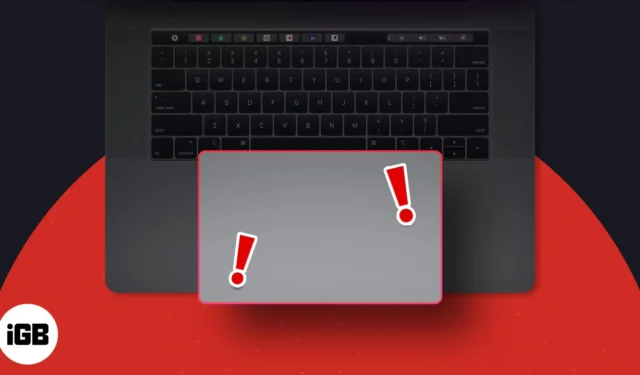
Unless you’re using some external accessory, the trackpad is the primary way you interact with your Mac. It affords you a range of gestures to help streamline your usage and boost your productivity. So, it can really get annoying when your MacBook trackpad is unresponsive, rendering your Mac almost useless. As long as it’s not a hardware issue, there are several ways to fix it. Below, I’ve mentioned some efficient ways to fix trackpad not working on MacBook.
- Clean your Mac’s trackpad
- Restart your Mac
- Update your macOS
- Disconnect accessories
- Disable Force Click
- Look for problematic apps
- Delete the. plist files
- Adjust Trackpad tracking speed
- Adjust Double Click Speed
- Reset SMC
- Reset the PRAM or NVRAM
- Reinstall macOS in Recovery Mode
- Check your battery
- Run Apple Diagnostics
- Reset Mac to Factory Settings
1. Clean your Mac’s trackpad
Before we do some in-depth troubleshooting, note that software and hardware failure are rarely the cause of trackpad issues. A dirty trackpad surface is the most common culprit for MacBook trackpad not responding.
Dust, dirt, or even grease from your fingers can prevent your Mac from registering your gestures properly.
- Turn off your Mac and try cleaning your trackpad with a dry microfiber cloth to see if this will resolve the issue. Be sure not to get any moisture in any openings.
- If the pointer feels jumpy, check your fingers and ensure they aren’t sweaty or damp. If they are, they may be the culprit behind your trackpad’s erratic behavior.
- Also, ensure that none of your hands touch the surface while your fingers perform gestures on the trackpad.
- Similarly, if you’re wearing jewelry, they might be touching the trackpad as you work, which may send multiple signals to your Mac and cause it to become confused.
2. Restart your Mac
As usual, before doing more sophisticated troubleshooting, we recommend trying this good ole’ tip since this is often more than enough to flush out bugs and glitches that may be messing with your Mac.
Try rebooting your Mac and see if this restores your trackpad’s function. Go to Apple Menu → Click Restart → Confirm by hitting Restart.
3. Update your macOS
Many software glitches and bugs can be easily avoided by downloading and running the latest OS, firmware, and driver on your Mac. To check if any updates are available for your trackpad:
- Head to the Apple menu → System Settings.
- Select General in the sidebar → Click Software Update.
- If an update is available, select Update Now.
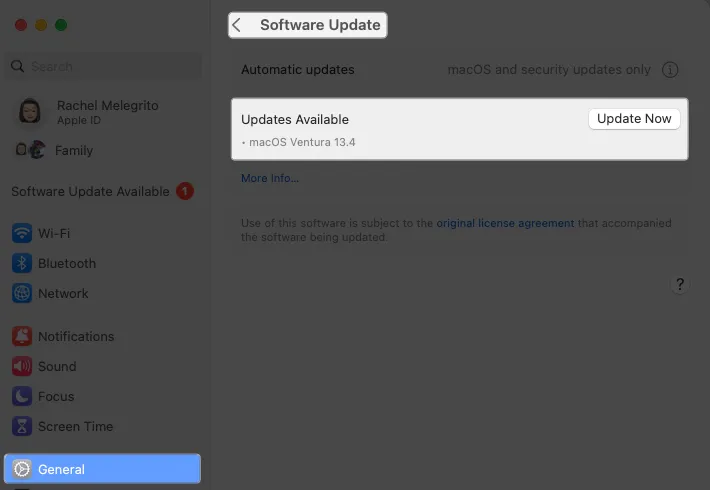
This update will also include firmware updates, which can help fix your trackpad not working on MacBook.
4. Disconnect accessories
While peripherals can’t directly cause harm, they may still interfere with your trackpad, so it’s best to rule them out.
First, try disconnecting any wired or wireless device, reboot your Mac, and see if the problem persists.
If you see the issue when you have a physical mouse connected to your Mac via Bluetooth or USB, your system may have been set up to ignore trackpad input when a mouse is connected.
- Change this setting by going to System Settings → Accessories → Pointer Control.
- Untick Ignore built-in trackpad when mouse or wireless trackpad is present.
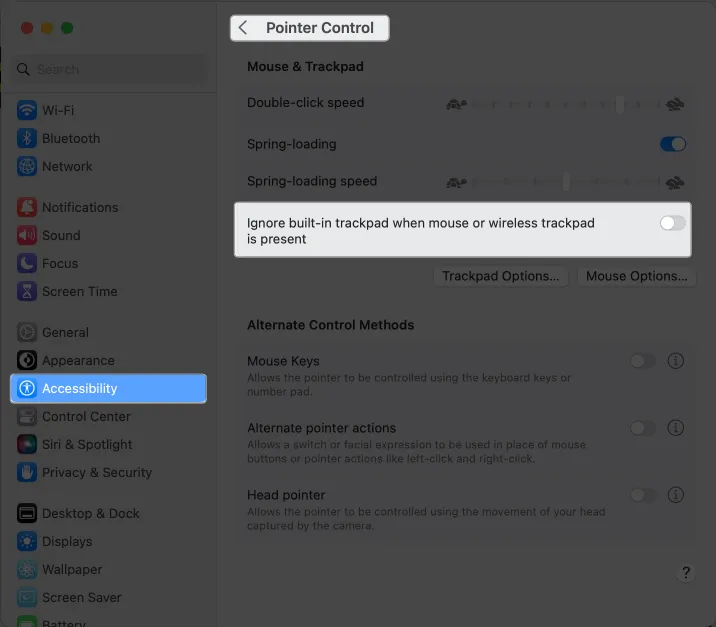
5. Disable Force Click
In case you aren’t aware, you can interact with your trackpad in two ways: Force Click and Tap to Click. The two differ in how much pressure you need to get a response from your trackpad.
While Tap to Click just requires you to tap on your trackpad to select items, you need to press firmly enough on the trackpad to hear a click and get haptic feedback when Force Click is enabled.
- Go to the Apple menu → System Settings.
- Select Trackpad from the sidebar.
- Toggle off Force Click and haptic feedback.
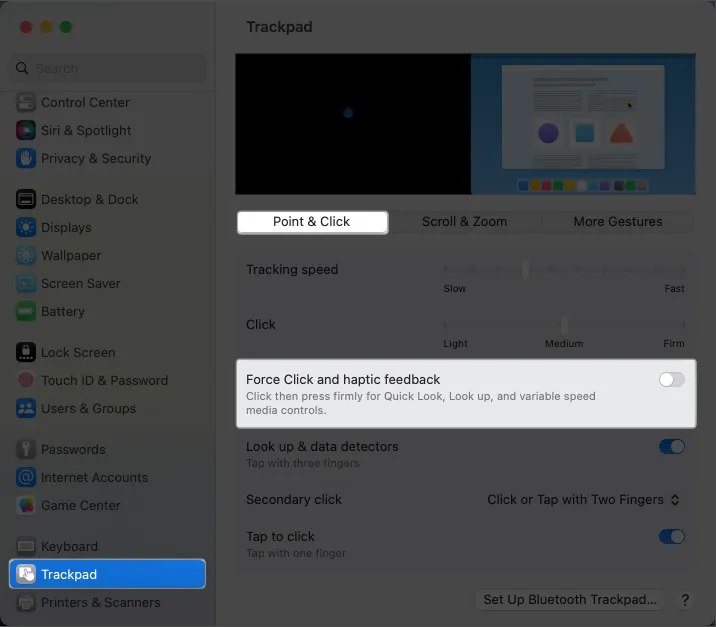
6. Look for problematic apps
If the trackpad was working fine but suddenly stopped working when you began using a new app or plugin, the new app might be the culprit. Try uninstalling the app or plugin and see if removing it does the trick.
7. Delete the. plist files
The macOS uses property list files or plist files to store user preferences, including settings and information about apps and bundles. Deleting them forces your device to recreate a new one.
- Open Finder → Select Go from the menu bar → Go to Folder.
- Type /Library/Preferences/ on the text field. Hit Go.
- Search for the following files one after the other and drag them to the Trash to delete them:
- com.apple.preference.track.plist
- com.apple.AppleMultitouchTrackpad.plist
- com.apple.driver.AppleBluetoothMultitouch.mouse.plist (for the Magic Mouse)
- com.apple.driver.AppleBluetoothMultitouch.trackpad.plist (for the Magic Trackpad)
- com.apple.driver.AppleHIDMouse.plist (for the wired USB mouse)
Once removed, reboot your Mac and see if this fixes the issue.
8. Adjust Trackpad tracking speed
If you have no issue with clicking, but your current tracking speed feels sluggish, you may increase it.
- Go to System Settings → Trackpad.
- Move the slider beside the Tracking speed to the right to increase its sensitivity.
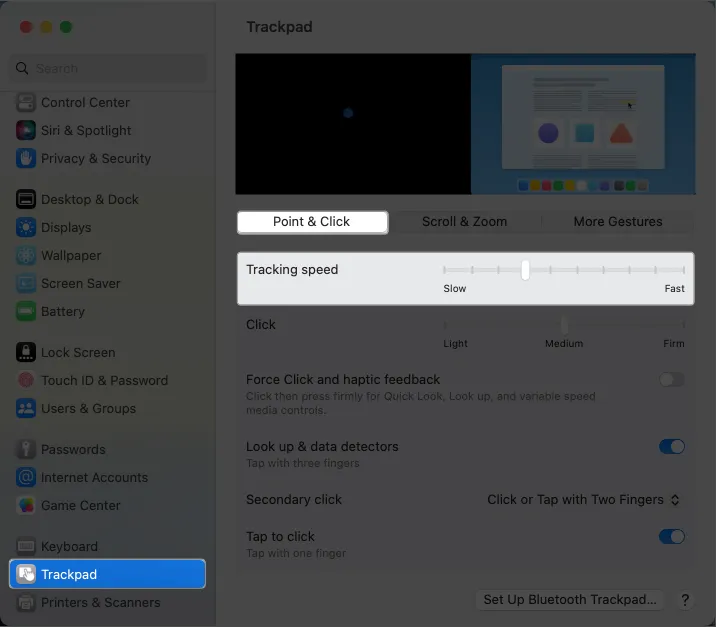
Reboot your Mac and check if your Trackpad is up and runnning.
9. Adjust Double Click Speed
If there’s no other issue with your trackpad except the ability to double-click, you may find it too long for your Mac to recognize the gesture.
This is common for people new to using trackpads instead of mice or if your fingers aren’t as nimble and swift as you’d like. Adjusting the double-click speed changes how fast you need to click for your Mac to recognize a double-click.
To adjust your trackpad’s double-click settings:
- Go to Apple menu → System Settings.
- Select Accessibility in the sidebar → Pointer Control.
- Adjust the Double-click speed. Lower it from its current position.
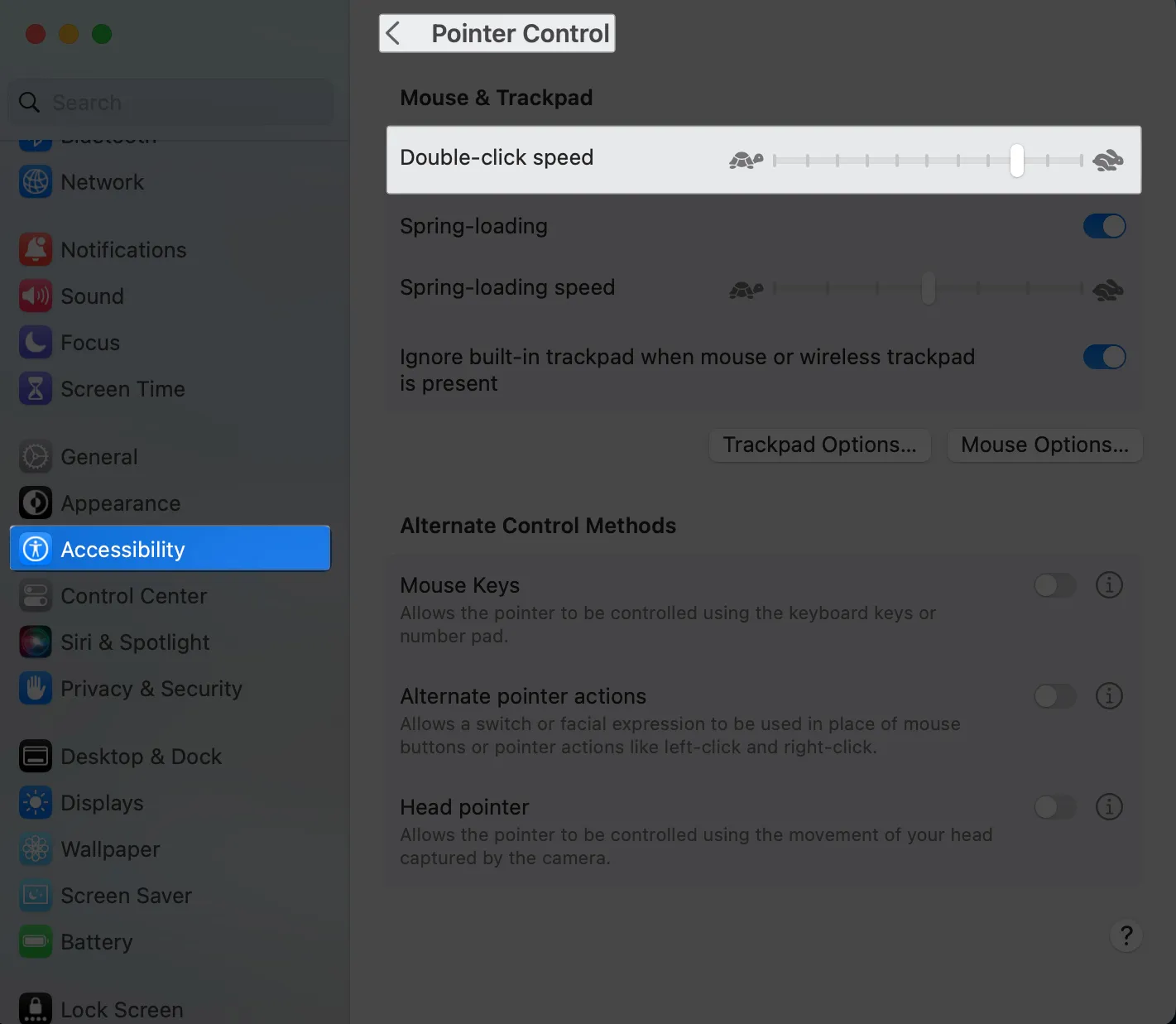
10. Reset SMC
The System Management Controller (SMC) is responsible for low-level settings, including battery status, keyboard and trackpad, and power and thermal management. Resetting it often helps solve a range of software issues and helps fix your problems with your trackpad.
Read our article on how to reset SMC and learn why you might want to do it. Note that this is only possible for Intel-based Macs. It’s not possible to reset the SMC on Macs with Apple Silicon because the chip takes care of this setting.
While you can’t reset SMC on your Mac with Apple Silicon, users reported that shutting down your Mac and waiting for at least 30 seconds does something similar to an SMC reset.
11. Reset the PRAM or NVRAM
If resetting SMC wasn’t effective, resetting the nonvolatile random-across memory (NVRAM) and parameter RAM (PRAM) may also prove valuable.
One potential cause of a faulty trackpad could be some type of hardware setting stored in the NVRAM or PRAM. For instance, if the trackpad’s settings get corrupted, and the corruption is stored in the NVRAM or PRAM, resetting these might help to fix the issue.
Read our detailed guide on how you can reset the PRAM or NVRAM on your Intel-based Mac.
Note that it isn’t possible to reset your NVRAM/PRAM on Macs with Apple Silicon. Your Mac automatically resets this when your machine detects a problem.
12. Reinstall macOS in Recovery Mode
OS 업데이트로 문제가 해결되지 않은 경우 macOS를 복구 모드로 다시 설치하면 문제가 해결될 수 있습니다. 이는 일반적으로 지속적인 소프트웨어 문제로 인해 발생하는 문제이지만 MacBook에서 작동하지 않는 트랙패드를 수정할 수도 있습니다.
13. 배터리 확인
트랙패드가 1초 동안 작동하다가 다음 순간부터 작동하기 시작한다면 Mac 배터리에 문제가 있을 수 있습니다.
그러나 Mac의 보증 기간이 아직 남아 있는 경우 첫 번째 단계는 Apple 지원에 문의 하거나 가까운 Genius Bar를 방문하여 수리 또는 교체가 가능한지 확인하는 것입니다. 그렇지 않은 경우 교체하고 문제가 해결되는지 확인하십시오.
14. Apple 진단 실행
모든 방법을 시도했지만 아무것도 작동하지 않는 경우 다음 단계는 하드웨어 문제가 있는지 확인하는 것입니다. 이를 수행하는 가장 좋은 방법은 Apple 진단을 실행하는 것입니다 .
진단 테스트 결과가 화면에 표시됩니다. 문제를 식별하는 데 도움이 될 수 있는 참조 코드를 기록해 두십시오. 하드웨어 문제가 있는 경우 가까운 Apple 서비스 제공업체에 문의하여 추가 지원을 받아야 합니다.
15. Mac을 공장 설정으로 재설정
다른 방법이 작동하지 않는 경우 Mac을 공장 설정으로 재설정하면 문제가 해결될 수 있습니다. 이는 모든 데이터를 지우고 Mac을 처음 꺼낸 것처럼 원래 상태로 되돌리므로 극단적인 단계이며 최후의 수단으로 고려해야 합니다.
MacBook의 트랙패드가 작동하지 않는 가능한 이유
문제 해결 팁 외에도 트랙패드가 Mac에서 작동하지 않는 이유에 대한 가능한 원인을 알아보고 이를 방지하는 것이 도움이 될 것입니다.
이 문제의 가장 일반적인 이유는 다음과 같습니다.
- 더러운 표면
- 소프트웨어 버그
- 트랙패드 기능에 영향을 미치는 의심스러운 앱
- 트랙패드 손상
- 설정 변경
- 손상된 OS
- 보류 중인 소프트웨어 또는 펌웨어 업데이트
- 하드웨어 오류
마무리…
MacBook에서 트랙패드가 작동하지 않는 문제를 해결하기 위한 문제 해결 방법이 너무 많습니다. 사소한 소프트웨어 버그로 인해 트랙패드가 제대로 작동하지 않는 경우가 많습니다. 빠른 재설정으로 해결할 수 없는 것은 없습니다. 그래도 문제가 해결되지 않으면 위에 나열된 다른 문제 해결을 시도해 보세요.
이 중 어떤 것이 효과가 있었나요? 아래에서 공유하세요!


답글 남기기